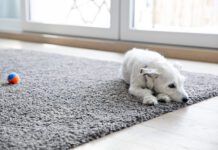[Updated January 28, 2019]
What could be better than curing your dog’s cancer? That’s easy! How about avoiding the illness in the first place?
No one has done any clinical trials or statistical studies that prove you can prevent cancer in at-risk dogs. “But common sense and clinical experience make a strong case for avoiding anything that exposes an animal to known carcinogens or weakens the immune system,” says Stacey Hershman, DVM, a holistic housecall veterinarian in Rockland County, New York.

Just like their human companions, dogs live longer, healthier lives when they eat the right foods, get enough exercise, breathe clean air, drink clean water, and stay away from harmful substances. They may also be helped by immune-boosting herbs, supplements, special foods, and a few things you might not have thought of. Here’s a review of recommendations from holistic veterinarians and other experts.
Good Genes
An important first step in selecting a puppy or adult dog is learning everything you can about the immediate family – parents, grandparents, siblings, aunts, uncles, cousins, etc. Some breeds are notoriously prone to cancer, and some lines within those breeds reinforce the trend. Look for good genes and good health when selecting puppies or adopting adult dogs.
Of course, rescued dogs seldom come with this documentation, and even the best-bred dog can develop cancer. But starting with good raw material can reduce the risk – and if you know that your dog may be prone to certain types of cancer, do what you can, starting today, to make that diagnosis less likely.
Spaying/Neutering
The statistics are convincing: female dogs have a significantly lower risk of developing mammary tumors if they are spayed before coming into season for the first or second time, and testicular cancer is obviously not a problem in neutered males.
But while early spaying reduces the risk of mammary cancer, it quadruples the risk of developing cardiac hemangiosarcomas (vascular tumors) compared to intact females. In addition, a study of 3,218 dogs neutered before one year of age showed that both males and females had a significantly increased chance of developing osteosarcoma (bone tumors) compared to intact males and females.
Understanding your dog’s inherited risks can help you make informed decisions about whether and when to schedule surgery.
Vaccinations
For Dr. Hershman and most holistic veterinarians, routine vaccinations top the list of things to avoid. “Vaccines really disrupt the immune system,” she says, “especially combination vaccines that are given annually.” Like many holistic veterinarians, she recommends a single-dose parvovirus vaccination at age 10 to 12 weeks, followed by a single-dose distemper vaccination four weeks later and a rabies vaccination after age six months.
“I check the effectiveness of these shots with blood titer tests,” she says. “If immunity is strong, there’s no need to revaccinate. If it’s weak, I repeat whatever the puppy needs for protection.”
Label directions warn veterinarians not to vaccinate a sick animal; Dr. Hershman includes injured or stressed animals in that caution. “Vaccinating a dog who’s being spayed, neutered, or treated for an injury is totally irresponsible,” she says. “You want the animal to be healthy, with a strong vital force, not in a weakened, vulnerable state, when you introduce substances designed to challenge the immune system.”
Responding to decades of research by immunologists, veterinary textbooks and colleges no longer recommend annual vaccinations for dogs, but most veterinary clinics continue to prescribe them. “They routinely prescribe antibiotics, steroids, and other symptom-suppressing drugs, too,” says Dr. Hershman, “and those take a toll on the immune system. Whenever you can use nutrition, homeopathy, acupuncture, medicinal herbs, or other natural therapies instead of symptom-suppressing drugs, you strengthen the dog’s immunity. A strong immune system is the best defense against cancer.”
The Right Diet
Advocates of home-prepared diets for dogs have long claimed that their animals are healthier than they would be on commercial pet food. Beth Taylor and Steve Brown, authors of See Spot Live Longer, agree. They blame dry and canned dog foods for a host of problems because they usually contain inferior-quality proteins, fats, and carbohydrates, a variety of toxins, highly processed grains, chemical preservatives, allergens, and other questionable ingredients.
Many veterinarians blame grain-based pet foods for diabetes, digestive problems, and other canine disorders. After all, the canine digestive tract evolved on a diet of prey animals, consisting mostly of meat and bones, not wheat and corn.
Every few years, aflatoxin, which grows on corn, rice, and other grains, contaminates pet foods and kills dogs (see “Yes, Dog Food Can Kill,” February 2006). In addition to causing liver damage, aflatoxin is a potent carcinogen, so even “safe” levels that don’t cause obvious disease outbreaks can contribute, over time, to cancer.
Another carcinogen found in grain-based foods is acrylamide, once believed to exist only in industrial waste. However, acrylamide has recently been found almost everywhere in the human diet. This tasteless, invisible by-product is formed when high-carbohydrate foods are fried or baked at high temperatures. French fries and potato chips contain the highest concentrations, but acrylamide occurs in breads and breakfast cereals as well.
The U.S. Environmental Protection Agency (EPA) considers acrylamide so dangerous that it set the “safe level” for human consumption at almost zero, with the maximum safe level in drinking water set at 0.5 parts per billion. A small serving of French fries contains over 400 parts per billion. No one has tested pet foods, but any processed foods that contain carbohydrates, especially those extruded at high temperature like grain-based kibble or canned under high heat and pressure, pose a risk.
“Considering how ubiquitous these carcinogens are,” says San Francisco-area dog health researcher Mary Straus, “and considering that cancer cells thrive on carbohydrates, avoiding grains altogether may be one way to help lower the risk of cancer.”
In addition to reducing levels of carbohydrates and carcinogens, feeding a home-prepared diet of pasture-fed, organically produced ingredients (see “Upgrading to Pasture-Fed,” July 2003) insures that your dog will not ingest pesticide and drug residues. Food prepared at home from conventionally farmed ingredients may not be free of pesticide residues, but it is unlikely to contain chemical preservatives, artificial colors or flavors, or the by-products of high-heat processing.
In his book, Work Wonders: Feed Your Dog Raw Meaty Bones, Australian veterinarian Tom Lonsdale observes, “We need more information about the cancer epidemic in domestic dogs. However, basic nutritional and medical principles tell us that diet is the likely main factor. Without waiting for extra information, and because cancer often takes years to develop, it’s best to start puppies on a cancer-prevention diet early. From the whelping box to the grave, let ‘Prevention, not treatment’ be our motto.”
Dietary Supplements
Antioxidant supplements, which help protect the body from damage by free radicals, have many health benefits, including cancer protection. Best-selling antioxidant supplements include vitamins A, C, and E, beta carotene, lycopene, and the mineral selenium. Bear in mind that some alternative cancer treatments, such as artemisinin, are not compatible with antioxidants.
Food-source antioxidants, vitamins, and other nutrients derived from whole foods are recommended by many holistic veterinarians because they are recognized as food by the body and are more easily assimilated than synthetic vitamins grown in a laboratory. The words “whole food” or “food source” indicate natural rather than synthetic ingredients.
One of the simplest cancer-resisting supplements you can add to your dog’s food, according to Bruce Fife, ND, is coconut oil. Dr. Fife, the author of several books about coconut’s health benefits, recommends feeding dogs 1 teaspoon of coconut oil per 10 pounds of body weight per day in divided doses. That’s 1 tablespoon (3 teaspoons) for a 30-pound dog and 2 tablespoons for a 60-pound dog. (See “Crazy About Coconut Oil,” October 2005.)
“The medium-chain fatty acids in coconut oil help treat or prevent all kinds of illnesses,” he says, “and they have significant anti-tumor properties. Giving your dog coconut oil every day is inexpensive health insurance.”
Dried shredded coconut (the unsweetened kind) is an excellent source of fiber, another factor in cancer prevention. Try adding a teaspoon to a tablespoon of shredded coconut to your dog’s home-prepared food. If feeding dry food, add a little water or soak the shredded coconut first.
Vegetables are controversial ingredients because they’re hard for dogs to digest. But a simple lactofermentation process not only improves the digestibility and assimilation of vegetables, it increases their vitamin content and makes them a valuable source of beneficial bacteria. In fact, the treated vegetables are both a prebiotic (food that feeds beneficial bacteria) and probiotic (food that contains beneficial bacteria). In Europe, lactofermented vegetables are the key ingredient in a popular cancer treatment.
To make lactofermented vegetables (see “It’s All in How You Make It,” March 2001), simply grate, shred, or puree carrots and other vegetables, add 1½ teaspoons unrefined sea salt per quart (4 cups) of vegetables, add the contents of a probiotic supplement such as acidophilus, and press everything in a bowl or glass jar until juice covers the vegetables. (The task is made considerably easier with a Japanese salad press; see “Cancer Prevention Resources” for purchasing information.)
Close the jar tightly or, if using a bowl, cover vegetables with a plate weighted by a jar filled with water. Let stand at room tem-perature until the vegetables give off a vinegar-like fragrance; this will usually take two to three days, depending on their con-sistency and room temperature. Refrigerate. Use to replace vegetables in any home-prepared recipe, or add 1 tablespoon to ¼ cup lactofermented vegetables to each meal.
Environmental Factors
Take two individuals from the same litter of puppies of a breed or family that has a high cancer risk. Place one with a family of heavy smokers who live next to a busy highway, use lawn chemicals, drink fluoridated tap water, and have high-current power lines in the backyard. Place the other pup on a pristine organic farm. Feed both the same diet and let several years go by. You don’t have to be an oncologist to know which dog is more likely to develop cancer.
Second-hand smoke is a serious problem for pets, especially those who spend hours every day at the feet of their smoking companions. “I tell all my clients who smoke that they’re putting their dogs’ health at risk,” says Dr. Hershman. “I saw it happen in my own family, and it breaks my heart. Second-hand smoke is as dangerous to dogs as it is to infants.”
Busy highways, driveways, parking lots, and areas where trucks and cars idle are dangerous for dogs because of gas and diesel exhaust. A dog’s nose is much closer to the ground – and exhaust pipes – than the human nose, so dogs are more likely to inhale damaging particles.
Lawn treatments and agricultural chemicals are known to cause cancer in animals (see “Canine Cancer Crisis,” November 2005). Dogs pick up pesticides, herbicides, and other chemicals through their feet and, when they sniff the ground, through their noses. Keep your dog off the grass in chemically treated neighborhoods, and explore organic alternatives for your own lawn and garden.
Even household chemicals pose a threat to our canine companions. According to the U.S. Consumer Product Safety Commission, more than 150 chemicals found in the average home are linked to birth defects, cancer, and psychological abnormalities. If labels carry a “keep away from children and pets” warning, or if product labels suggest they should be used only in well-ventilated areas, look for alternatives.
Fluoride has gotten such good press over the decades that most Americans think it’s essential for healthy teeth. It’s even added to some canine toothpastes. But in many countries, fluoride is considered a hazardous industrial waste, and its use in water supplies is prohibited. In September 2005, eleven unions representing more than 7,000 scientists and researchers at the EPA called for a national moratorium on the fluoridation of America’s drinking water, citing cancer risks.
A December 2005 analysis of more than 22 million tap water quality tests, most of which were required under the federal Safe Drinking Water Act, found that water suppliers across the U.S. detected 260 contaminants in public tap water. Of the 141 unregulated contaminants detected in water supplies between 1998 and 2003, 52 are linked to cancer, 41 to reproductive toxicity, 36 to developmental toxicity, and 16 to immune system damage. Water contaminated with 83 agricultural pollutants, including pesticides and fertilizer ingredients, flows through the taps of over 200 million Americans in 41 states.

Installing a water filter or using uncontaminated, unfluoridated bottled water sounds like a very good idea! So does avoiding fluoridated toothpaste.
Regarding sources of electromagnetic radiation, a study published in 1995 in the American Journal of Epidemiology compared dogs treated at a veterinary teaching hospital for histologically confirmed lymphoma. Electric wire codes and magnetic fields were measured at the homes of 93 diagnosed cases and 137 controls, and a correlation was found between magnetic fields emitted by power lines and electrical appliances and the incidence of lymphoma. Dogs living in homes with very high current codes had the highest risk, while dogs living in homes with buried or underground power lines had a lower risk.
Immunologist and veterinarian Richard Pitcairn, DVM, PhD, author of Dr. Pitcairn’s Complete Guide to Natural Health for Dogs & Cats, considers all sources of radiation (including repeated diagnostic X-rays) dangerous because their effects are cumulative in the body. He recommends that dogs not be allowed to rest near a color TV set. Fortunately, the new flat-screen TVs and computer monitors emit much lower levels of electromagnetic radiation than older cathode ray tube models. In general, the fewer electrical appliances in close proximity to pets, the better.
Topical Pesticides
Anyone who lives where fleas, ticks, or mosquitoes are a problem knows what a challenge they can be. Unfortunately, topical and systemic pest-control products contribute to a host of health problems, including increased cancer risks.
A well-balanced raw diet can help a dog repel parasites, but sometimes the attack is overwhelming.
“I definitely prefer natural alternatives to pesticide sprays or products like Frontline, which make the entire dog toxic to biting parasites,” says Dr. Hershman. “But alternatives don’t always work. One of my patients is a raw-fed Search and Rescue dog who often picked up more than 200 ticks on training weekends. He’s a German Shepherd Dog, so finding and removing them all was a time-consuming, stressful challenge. After his owner tried every natural repellent we could find, none of which solved the problem, he now applies K9 Advantix, a systemic pesticide that repels fleas, ticks, and mosquitoes, on a reduced dosage schedule only when needed.
“When it comes to cancer prevention,” she says, “the less often you use conventional pesticides, the better. A good diet and natural repellents are always worth trying first.”
Cancer Preventives
Several holistic cancer treatments, such as those described in “What Are the Alternatives?” (February 2006), can be used to help healthy dogs remain cancer-free. The thinking here is that cancer cells develop all the time, even in healthy bodies, but they don’t create problems until conditions encourage their growth. Preventive treatments disrupt cancer cells before they take up residence in vulnerable parts of the body.
Henry Lai, PhD, the University of Washington researcher who first tested artemisinin (an extract of Artemesia annua, or annual wormwood) on dogs with cancer, takes artemisinin as a preventive himself and has tested it on laboratory animals.
“It is hard to recommend a protocol for cancer prevention,” he says, “but, based on studies on rats, a good dose could probably be somewhere between 8 milligrams of artemisinin per kilogram of body weight per day at the high end and 10 mg/kg once per week at the low end. I take 100 mg per day for 10 days each month. Even though this approach hasn’t been tested yet on humans or canines, I think it makes sense.”
Following Dr. Lai’s example, a dog weighing 60 to 75 pounds could take 50 mg artemisinin for 10 days each month, and the amount could be increased or decreased as needed for larger and smaller dogs.
The antioxidant Protocel, also discussed in last month’s article, can be used in a similar way.
According to Illinois veterinarian Dan King, DVM, “This should be effective because Protocel works on early cancer cells as an antimetastatic. That is, it deals with individual cells and prevents them from spreading and growing. Because it works slowly, I would use Protocel on a preventive maintenance schedule of ¼ teaspoon twice per day for a dog weighing 50 to 75 pounds for three months on and six months off. Small dogs could take 1/8 teaspoon twice per day for the same length of time.”
Medicinal Herbs
Ask a dozen experts about their favorite herbs for cancer prevention and you’ll generate a list too long to publish here. But a few herbal products are so effective that they are recommended by almost everyone.
“Many mushrooms have anti-tumor and immune-stimulating activity,” says Carol Falck, VMD, of Pompano Beach, Florida. “They have been used medicinally for thousands of years in China and Japan, and they work very well for dogs.”
Dr. Falck often uses Myco-Immune by Thorne Research, which is a liquid extract of seven medicinal mushrooms, including cordyceps, reishi, shiitake, maitake, and turkey tail. “This combination stimulates the immune system in several ways, helping it resist the growth of cancer.”
She also recommends a green tea extract (G.T.-Ex by Thorne Research) because green tea enhances cellular immune function, increases natural killer cell activity, and may inhibit some cancer cell lines.
Another favorite supplement for dogs at risk of cancer is curcumin, says Dr. Falck. “Curcumin is the yellow pigment in turmeric, the spice that gives curry its distinctive color. Both turmeric and curcumin have been shown to inhibit tumor growth. I also like astragalus, an herb with strong immune-stimulating properties. I use several Chinese herbal formulas containing astragalus, depending on the patient, including Astragalus for Animals by Buck Mountain Botanicals.”
Garlic is well known and often used for its cancer-inhibiting properties. Small amounts of fresh minced garlic or aged garlic extract can be added to any dog’s dinner. Garlic is an ingredient in Herbal Compounds tablets created by Juliette de Bairacli Levy, whose Natural Rearing philosophy pioneered home-prepared diets and alternative medicine for animals.
“This formula is very antiseptic,” says Natural Rearing advocate Marina Zacharias, who imports the product from England. “It definitely helps the immune system.”
For patients at high risk, Zacharias likes a Chinese formula called Bioprin for its antiviral, antibacterial, antifungal, and anti-tumor properties. “I also use a probiotic called Florenz and, over the animals’ life span, a form of liver support given to match their needs, such as homeopathic Liver Terrain.”
Zacharias says she has seen good results from prevention efforts taken to protect individual dogs in high-risk families. “Of course, there is no empirical evidence to say that these measures prevented cancer, but when we see a good-quality, healthy life, it’s evidence that the efforts are warranted. We all have to die from something, but when we see cancer in a naturally raised dog, it’s usually when the dog is older, at the end of its natural lifespan.”
Closely related to herbal medicine is aromatherapy. San Diego holistic veterinarian Stephen Blake recommends massaging the paw pads of at-risk dogs once or twice per day with a drop of blended frankincense, sandalwood, and Douglas fir essential oils. For best results, use organic or wildcrafted oils from reputable distributors as described in “Essential Information” (January 2005). “These essential oils are great for detoxification and for supporting the immune system,” he says.
Exercise
Although few of us appreciate the important role it plays, the lymph system is a key factor in cancer prevention. Lymph is a clear fluid, similar to blood but lacking red blood cells. It contains the immune system’s lymphocytes (T-cells and B-cells) and circulates through channels that carry waste to the lymph nodes, filtering bacteria and other toxins.
The more lymph circulation is impaired, the less efficiently the body removes toxins and the more favorable conditions are for the growth of cancer. Lymph circulation improves with active exercise and deep, diaphragmatic breathing. Gentle to vigorous brushing that moves from the feet to the heart is a simple addition to daily grooming that also stimulates lymph circulation.
“Exercise is so important,” says Dr. Falck. “Exercise stimulates the immune system and releases endorphins, and an added benefit of consistent exercise is increasing gastrointestinal motility, which helps normalize stools and eliminate toxins from the body. It also facilitates weight management, which is important because obesity is a risk factor for some types of cancer.”
Malillumination
You probably haven’t thought about light as a cancer preventive, but it may well be. Not just any light, though. Unfiltered natural light, Mother Nature’s full-spectrum light, activates the hypothalamus and keeps the entire endocrine system balanced.
When photobiologist and time-lapse photography pioneer John Ott began to photograph living plants, he discovered that depriving them of unfiltered natural light interfered with their normal growth and reproduction.
He soon learned that the health of fish, birds, reptiles, and other animals (including humans) is adversely affected by insufficient light and by the wrong kind of light, especially fluorescent light. Ott coined the term “malillumination” to describe the phenomenon, which is now known to suppress immune function and contribute to skin damage, cancer, and other problems.
Light enters the eyes not only to facilitate vision but also to activate the hypothalamus. This region of the brain, in turn, controls the nervous and endocrine systems, which regulate functions throughout the body.
Exposure to natural light, preferably for several hours daily, is necessary for your dog’s health. A shady screened porch, the shelter of a tree, even an open window or doorway can give the dog’s body what it needs. Some plastics allow the transmission of full-spectrum natural light, but glass windows, windshields, and sunglasses (which we hope your dog doesn’t wear) do not.
Emotional Well-Being
For many healthcare experts, emotional well-being is as important to cancer prevention as diet and exercise.
“I believe strongly that emotions are linked to general health via the immune system,” says Dr. Falck. “We can support our pets emotionally by encouraging social interaction with people and other animals, by providing a safe and loving environment with balanced opportunities for play and rest, and by minimizing stress.”
Dr. Blake strongly stresses the importance of positive thinking.
“Never talk to an animal as though he or she is a tumor instead of a spiritual being,” he says. “Negative thoughts generate negative energy, which feeds the disease and weakens the patient’s vital force. No matter how serious the risk of cancer, it’s important to picture your dog as well and happy, not sick, and to engage him or her in meaningful conversation and meaningful activities every day.”
A long-time contributor to WDJ and author of The Encyclopedia of Natural Pet Care, Natural Remedies for Dogs & Cats, and other books, CJ Puotinen lives in New York with her husband, a Lab, and a tabby cat.





